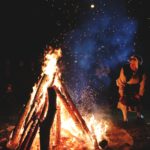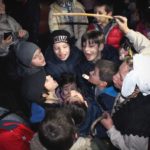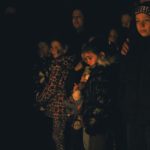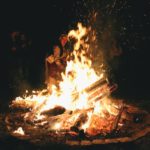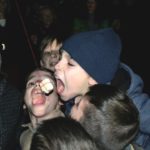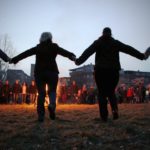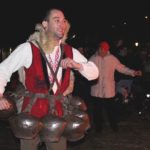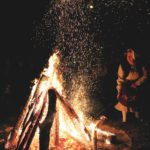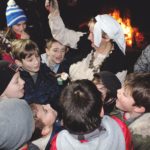The Tradition of Sirni Zagovezni
On Sunday 18th January 2018, Sirni Zagovezni was celebrated near Kulata Ethnographic complex in Kazanlak. The(Y) Volunteers team had the opportunity to participate in the celebration and to talk about this tradition with Dora Petkova, Chairperson of the “Fire“ Cultural Centre of Kazanlak and main organizer of the event together with the Municipality of Kazanlak.
Sirni Zagovezni tradition in the Bulgarian festive calendar
Winter and pre-spring traditions of the Bulgarian festive calendar are symbolically related to the end of the old year and the advent of the new one. Rituals, dances and masquerade games around feast fires are traditionally performed in this period of the year to chase away evil spirits and to purify beings in preparation for the awakening of nature. All of them represent the wish for health, fertility and prosperity. All of them are moments of joy, purification and forgiveness. It is a unique mix of customs shaped by pagan elements and Christian ones.
Sirni Zagovezni (Shrove Sunday) is the last celebration of the winter festive cycle that best embodies this meaning. It is celebrated on the Sunday preceding the Great Lent (Todorova Nedelia), seven weeks before Easter, marking the beginning of the longest period of fasting throughout the year. As Dora explains, this festive day is part of the ritual cycle of Easter, where is avoided meat firstly (Zagovezni), diary products a week after (Sirni Zagovezni) and, finally, eggs on the following Saturday (Todorovden, the day of St. Theodor). “Strong believers don’t eat in the next three days after Sirni Zagovezni, just drink water. […]

On Todorovden, the main customs are the horse race called kushia and a competition where people sting each other with crayfishes. These river crustaceans are also pin on clothes as amulets. “In one small village nearby Kazanlak this ritual is very typical. […] If the are no crayfishes, a typical dish in the banquet of this celebration is dry red pepper which symbolizes crabs. Other common Bulgarian specialties are: sarmi, rolls of stuffed cabbage leaves made with veal, pork, rice, and yogurt, and chicken stuffed balls with truffles. All these special rituals and food are typical of the cycle.”
Dora also points out that, in the old Bulgarian calendar, men’s purifying rituals are separate from women’s ones, because men and women have a different roles: “if the man is the seed, the woman is the garden level”. Male fertility is celebrated especially during winter, when takes place the purifying process for men with Kukeri masquerade rituals and the traditional jump over the fire. Naturally girls and women can take part in them, but they are not allowed to wear masks. If they do it, it is a kind of exception. The purifying ritual for women is actually performed few months later in late spring on Kostadinovden (the day of St. Constantine and Helena). During this day, women purify their bodies and souls by dancing barefoot on live coals, performing the fire-dance known as Nestinarstvo, very popular in the Strandzha Mountain region located in Southeastern Bulgaria.”
Sirni Zagovezni: a day for purification and forgiveness
“Everything what people do during this celebration is based on faith”, tells Dora. All over the world fire is a symbol for purification and one of the essential rites on Sirni Zagovezni is lighting up a feast fire at the dawn. People usually dance the horo (circle dance) around this fire and their foreheads are marked with ashes from it.
Kukeri, men wearing ancestral masks and costumes whose presence is purifying, also join the celebration. According to Dora, Kukeri performances are typical in Kazanlak region during celebrations as Sirni Zagovezni, but masks and costumes can be worn only in the period from Ivanovden (the Day of St. John) until Todorovden. Afterwards, wearing them is generally forbidden, because it would bring bad luck and illnesses.

Kukeri masks and costumes carry in fact a special meaning: they are means of purification. “If an old person is sick or a child is naughty, Kukeri go to their homeplace to purify them. By taking a piece of wool -the typical material for the masks and costumes from this region- and puttin it close to the heart of elderly people and children, they protect them from bad energies. […] If you have faith you can be rejoiced and that is the main meaning of this tradition.”
Another popular ritual during Sirni Zagovezni is Hamkane, where kids and the oldest person of the local community take part. The second one moves around in circles a peeled boiled egg or a piece of halva (white nougat), tied to a red thread. Children have to catch it with their mouths only and who wins will be happy and healthy for the all-year-round. The ritual ends with the burning of the thread, another sign of purification and prosperity.

Jumping over the fire is an important closing rite of Sirni Zagovezni, though is typical only in some regions of Bulgaria, as Dora explains. “Where people don’t jump over fire, they make bonfires as high as they can to lighten up as many houses as possible in villages and towns. Main villages or towns may also compete against each other to have the biggest bonfire. […] The main idea behind all these rituals with fire is to wake up the heart from the winter. It’s a rebirth.”
Sirni Zagovezni is also the day of forgiveness. This is the time when young people apologize to older members of the family for their mistakes. As Dora points out, there is no option to do it otherwise, from older to younger ones, because the first are more experienced and wiser. This tradition is still alive nowadays and is done from son to father or from daughter to mother.

There is also another important figure, rooted in Bulgarian orthodox tradition, who takes part in it: the kum (Godfather or Godmother). A kum is witness of the birth and the baptism of a child, as well as protector for the entire life.
Other customs connected with Sirni Zagovezni
According to Dora, the custom of arrows (Chilkane or Tuykane) was also common on Sirni Zagovezni, but nowadays has been stopped for safety reasons. Every boy used to prepare his arrows: sort of little rockets made from bark, which must be lightened with the ritual fire. Boys used to launch them in the air drawing circles above the head and aiming to their sweethearts’ homes as declarations of love. Parents of unmarried girls used to welcome those burning signs of love with water-filled pots and wet canvas on the roofs.The girl who collected the largest number of arrows was considered to be the most beautiful and desirable young lady in the village. Eventually, boys could show their love by removing parts of the house, such as doors or roof tiles.
Sirni Zagovezni is also the very first time in which a couple of young lovers present itself to the village or town community and can dance horo hand in hand around the bonfire. As a matter of fact, there is a courtship ritual that has to be performed previously. Young men and boys go from house to house with a shepherd stick and sing songs. As a sign that a girl likes a boy, she put on his stick a circle bread that she baked in advance. Right after that the young couple can tell about the engagement only to their families. Naturally, the girl involved has to be a lazarka.

This means that she took part in the spring female celebration known as Lazaruvane, dedicated to love and fertility, and she is ready to be married. This is the day when girls say goodbye to their childhood and prepare themselves for a future wedding. Dressed in festive clothes and with flower garlands on their heads, girls go to houses, wishing the hosts health and prosperity, and perform ritual horo dances. Then every girl throws her flower crown on a river as a sign that she has become a lazarka.


